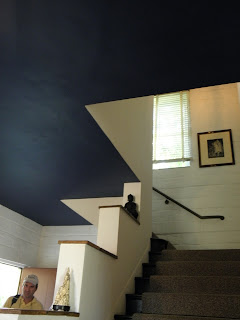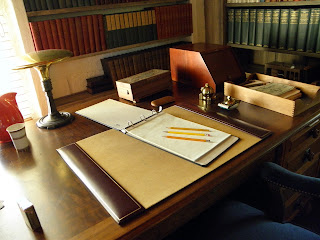A year ago or so, I hadn’t heard of the American playwright, Eugene O’Neill. I first was introduced to him by a co-worker and second by an acquaintance who knew my love of writing. She said I would probably appreciate a visit to the home, and so a seed was planted—two seeds—a third, and then, I found myself there.
When my co-worker pal mentioned O’Neill and his autobiographical play, “Long Day’s Journey into Night,” way back then, I decided that before I visited the Tao House, I wanted to first read that play, which was written in that very house. The play flowed easily and the descriptions were visual, so that I could see and hear everything. I was right there. It is really a sad autobiographic picture of O’Neill’s life injected, sometimes, with black humor. Though at its core, it is pure pain turned to art. I found myself laughing and crying. “Long Day’s Journey into Night” held my attention and pulled me along into O’Neill’s subterranean world, into the characters—the real people there on those pages. And though it was autobiographical, it was also relatable and it reemphasized for me how the best material does come from deep inside of us—it comes from our pains, our truths—as we know them—then shaped into a so called fiction; and at other times, laid out there in all their truth.
It’s been about two month’s now since my visit to Eugene O’Neill National Historic Site, The Tao House, located in Danville, California.
There were many surprises because I didn’t know much other than what I read on the visitor’s website. By the very name of the house, one can conjure an image of what may be encountered, but I went with no vision.
The shuttle wound through the neighborhood up to the home of Eugene O’Neill. He lived here with his third wife, Carlotta. She found the property and worked with the architects to build this house, to bring East and West together into this abode where O’Neill, The Master, as they called him would write several plays. All understood, under no circumstances, was The Master to be disturbed when he was busy at work writing.
Nestled away in the wilderness, The Tao House, is but a short drive to town, yet one feels a sense of personal wilderness, of being tucked far away. The exterior of the home is of a Spanish style, white brick and some terracotta, met with Chinese elements seen in the tiling of the roof and pieces set around the exterior of the home and throughout the interior.
Upon entering the home, one is greeted with Asian masks of Chinese and Japanese origins. Much of the house has been arranged with Feng Shui principles. The Park Ranger Educator points out the mirrors of different shades, the Chinese Fu Lions that adorn each side of the stairs to the second floor of the home, and blue ceilings and brown tiled floors for the water and earth elements.
The room that made the most lasting impression upon me was O’Neill’s bedroom. Several rooms had tinted inset mirrors of yellow, blue, or green , but his room was the only one that had a black mirror set into the wall. I couldn’t really see my reflection very well. It beckoned me to come closer though, to keep looking, and I felt as though I was looking into nothingness, into the dark, as though, I could slip right through. It made me feel a slight shutter, at seeing a black mirror that almost made me forget the rest of the room. Something about this mirror made me think and made me feel that each viewer, especially with this particular mirror, would most definitely feel something very different or maybe the same?
O’Neill loved the sea and his writing room was a reflection of that love, as well as a stark contrast to the feel of his bedroom. Besides the kitchen, his writing room was one room in the home that did not seem to have a heavy Chinese element to it. He also loved his beloved Dalmatian, Blemie. Of all the photos displayed in the home, only one shows O’Neill with a beaming smile on his face, and that is the one with his beloved Blemie by his side in a side embrace.
I am glad that I finally entered Eugene O’Neill and Carlotta’s Tao House—glad to have visited their world reflected in their home, and experience their sacred space, where O’Neill wrote for the last time.
**
Eugene O’Neill (1889-1953)
American Playwright
“Father of American Drama”
**
Information on how to visit the Tao House.
Eugene O’Neill Foundation ~ Learn and see about O’Neill’s time at the Tao House.
An Electronic Eugene O’Neill Archive
Eugene O'Neill quote from:
**
I wanted to share some photos that I took, to show you what I saw through my lens on that day.
Views from around the house
Exterior views of Tao House
Entryway
Can you tell which Fu Lion is female and which is male?
Upstairs
Carlotta's bedroom
O'Neill's study - Carlotta typed all of his work from this most tiniest of writing. I couldn't even read it with that magnifying glass.
This is a closet in the hallway. I was struck by the efficient use of space done in an aesthetically appealing way. Those white drawers are perfect for keeping everything in order and out of site and then, as you can see, the red door closes, so that it all becomes one beautiful concealed piece. There were also many book nooks built into the walls. Books, books, everywhere!
Back downstairs
The living room
Front yard
Blemie's grave site.
O'Neill's beloved dog, Blemie, rests about 100 feet from the front of the house amongst the trees and critters.
Though O'Neill did not pass away at the Tao House, his spirit is very much there, and he did write his last works there. The docent educator shared the famous quote that O'Neill uttered while on his death bed:
"I knew it. I knew it. Born in a hotel room - and God damn it - died in a hotel room."
~~ Eugene O'Neill, writer, d. November 27, 1953
~~ Eugene O'Neill, writer, d. November 27, 1953
**




































10 comments:
Rebb, thanks for the tour! Beautiful pictures that really capture the spirit of the house.
I love when you say: "the best material does come from deep inside of us—it comes from our pains, our truths—as we know them—then shaped into a so called fiction; and at other times, laid out there in all their truth." I agree with that: every work of art is in a certain degree autobiographical. We can´t be someone else when we create. If we think we can, we´ll be frustrated and our work will be false.
Rebb,
Wow, very entertaining. I wonder how you can display so many photos. I can only upload up to five.
Yes, I see some Japanese masks. The other day, I watched a video of "Dojo-ji." It is the most popular Noh drama, and I found a complete educational video about it in the library. I don't know how many times I've seen Dojo-ji in dance and Kabuki and Noh. So, I've probably seen the same mask or similar ones over and over again. But each mask draws me into a world each time. I think Eugene O'Neal owned good quality masks. He probably identified with Noh plays. They all seem so dramatic and tragic.
Rebb,these are fabulous pictures.I have an urge to visit this place sometime.
Thanks, Lu. I’m glad that you felt the pictures captured the spirit of the house. So true, too, that “we can’t be someone else when we create.” And I’m so glad for that! You are right, it would be most frustrating and our work would lack authenticity of self.
Keiko, Great! I’m so glad you were entertained :) I had to upload a small batch of photos at a time. I tried to do all of them, but I could not. So, I had to be patient.
The “Dojo-ji” video sounds interesting. I love masks. They are mysterious and I agree, they seem to have that affect of drawing us into a world. For you though, the experience much be much larger, since masks seem more entwined with your culture. Interesting…yes, you are probably right about Eugene O’Neill identifying with Noh plays.
How nice to see you, Jitu! I’m glad you like the pictures and that you have the urge to visit. I hope that you are able to visit in real time one day.
Rebb,
About Tao, our blogs all came together this week: Yours, Vincent's, and mine. I've been soaking almonds in hot water and eat. It is just right and quick. I love it. I eat more than five, but I bought the package from Trader Joe's.
Thanks for this, Rebb. I had heard of Eugene O'Neill. I remember at university seeing posters for "The Iceman Cometh". I never took an interest, and indeed thought he was an Irish playwright. So I'm grateful for this wealth of detail.
Keiko, I’m so glad you are eating your almonds. I still need to go out and buy some. Good idea. I’ll try Trader Joes.
Vincent, I’m glad you were able to get something out of the blog. I grateful that I was introduced to O’Neill’s work; otherwise, I would have missed out on a great playwright. I had the opportunity to see one of his short works performed about a month back. It’s called “The Hairy Ape.” The actor for the lead, Yank, gave an outstanding performance. I would very much like to see “Long Day’s Journey into Night.” I am keeping my eyes open, but it does not appear there is anything in California slated so far. I would travel, but within reason.
That’s interesting that you remember seeing the posters. I know that typically plays are not meant to be read, but I would also like to read “The Iceman Cometh.” As I understand, another very autobiographical work of his.
Post a Comment